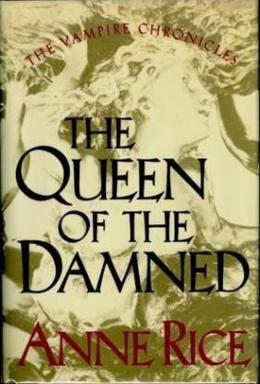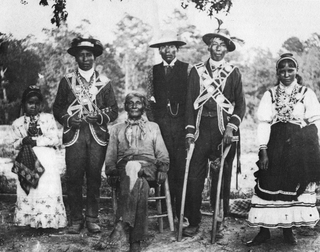Related Research Articles

The Queen of the Damned (1988) is a vampire novel by American writer Anne Rice, the third in her The Vampire Chronicles series. It follows Interview with the Vampire and The Vampire Lestat. This novel is a continuation of the story that ends in a cliffhanger in The Vampire Lestat and explores the rich history and mythology of the origin of the vampires, which dates back to Ancient Egypt.
Latvian mythology is the collection of myths that have emerged throughout the history of Latvia, sometimes being elaborated upon by successive generations, and at other times being rejected and replaced by other explanatory narratives. These myths stem from folk traditions of the Latvian people and pre-Christian Baltic mythology.

Choctaw mythology is part of the culture of the Choctaw, a Native American tribe originally occupying a large territory in the present-day Southeastern United States: much of the states of Mississippi, Alabama, and Louisiana. In the 19th century, the Choctaw were known to European Americans as one of the "Five Civilized Tribes" even though controversy surrounds their removal.

In Nguni mythology, Tikoloshe, Tikolosh, Tokoloshe, Tokolotshe, Thokolosi or Hili is a dwarf-like water spirit. It is a mischievous and evil spirit that can become invisible by drinking water or swallowing a stone. Tokoloshes are called upon by malevolent people to cause trouble for others. At its least harmful, a tokoloshe can be used to scare children, but its power extends to causing illness or even the death of the victim. The creature might be banished by a pastor, who has the power to expel it from the area. It is also considered a part of superstition and is often used in a satirical manner as a reference to overcome.

Vorarephilia is a paraphilia characterized by the erotic desire to be consumed by, or to personally consume, another person or creature, or an erotic attraction to the process of eating in general practice. Soft vore fantasies are separated from sexual cannibalism, also referred to as "hard vore", because the living victim is normally swallowed whole. The word vorarephilia is derived from the Latin vorare, and Ancient Greek φιλία.

Filipino witches are the users of black magic and related practices from the Philippines. They include a variety of different kinds of people with differing occupations and cultural connotations which depend on the ethnic group they are associated with. They are completely different from the Western notion of what a witch is, as each ethnic group has their own definition and practices attributed to witches. The curses and other magics of witches are often blocked, countered, cured, or lifted by Filipino shamans associated with the indigenous Philippine folk religions.
A shtriga is a vampiric witch in Albanian mythology and folklore that sucks the blood of infants at night while they sleep, and then turns into a flying insect. Only the shtriga herself could cure those she had drained. The shtriga is often pictured as a woman with a hateful stare and a horribly disfigured face. They usually live in hidden places in the forest and have supernatural powers. The term shtriga is used also with the common meaning of "witch", referring to a bad and ugly old woman who casts evil spells upon people. The male noun for shtriga is shtrigu or shtrigan.
The Doomspell Trilogy is a trilogy of fantasy novels by Cliff McNish.

The erebid moth Ascalapha odorata, commonly known as the black witch, is a large bat-shaped, dark-colored nocturnal moth, normally ranging from the southern United States to Brazil. Ascalapha odorata is also migratory into Canada and most states of United States. It is the largest noctuoid in the continental United States. In the folklore of many Central American cultures, it is associated with death or misfortune.

Brother Voodoo is a character appearing in American comic books published by Marvel Comics. He first appeared in Strange Tales #169. The character was created by publisher Stan Lee, Roy Thomas, Len Wein, and artist John Romita Sr. Since replacing Doctor Strange as Sorcerer Supreme in The New Avengers #53, the character is referred to as Doctor Voodoo.
Salem's Seven is a fictional team of magical beings and former supervillains appearing in Marvel Comics. They were initially foes of the Scarlet Witch and the Fantastic Four, but became allies to both. All seven are the children of Nicholas Scratch and the grandchildren of Agatha Harkness. They are humans with magic powers who can transform into fantastic creatures with super-powers.

Brazilian mythology is the subset of Brazilian folklore with cultural elements of diverse origin found in Brazil, comprising folk tales, traditions, characters and beliefs regarding places, people, and entities. The category was originally restricted to indigenous elements, but has been extended to include:

Satana Hellstrom is a fictional character appearing in American comic books published by Marvel Comics. Created by Roy Thomas and John Romita Sr., she first appeared in Vampire Tales #2. Satana belongs to the species of magical beings called demons, who are born with supernatural abilities, as a human-demon hybrid. She is the younger sister of Daimon Hellstrom and the daughter of Marduk Kurios.

A zduhać and vetrovnjak in Serbian tradition, and a dragon man in Bulgarian, Macedonian and southern Serbian traditions, were men believed to have an inborn supernatural ability to protect their estate, village, or region against destructive weather conditions, such as storms, hail, or torrential rains. It was believed that the souls of these men could leave their bodies in sleep, to intercept and fight with demonic beings imagined as bringers of bad weather. Having defeated the demons and taken away the stormy clouds they brought, the protectors would return into their bodies and wake up tired.

Legends of vampires have existed for millennia; cultures such as the Mesopotamians, Hebrews, ancient Greeks, and Romans had tales of demonic entities and blood-drinking spirits which are considered precursors to modern vampires. Despite the occurrence of vampire-like creatures in these ancient civilizations, the folklore for the entity known today as the vampire originates almost exclusively from early 18th-century Southeastern Europe, particularly Transylvania as verbal traditions of many ethnic groups of the region were recorded and published. In most cases, vampires are revenants of evil beings, suicide victims, or witches, but can also be created by a malevolent spirit possessing a corpse or a living person being bitten by a vampire themselves. Belief in such legends became so rife that in some areas it caused mass hysteria and even public executions of people believed to be vampires.

Shelter is a 2010 American supernatural thriller horror film directed by Måns Mårlind and Björn Stein, written by Michael Cooney, and starring Julianne Moore and Jonathan Rhys Meyers. The film was released as 6 Souls in the United States on March 1, 2013, for video on demand, followed by a limited theatrical release on April 5, 2013.

Witchcraft among the Zande people of North Central Africa is magic used to inflict harm on an individual that is native to the Azande tribal peoples. The belief in witchcraft is present in every aspect of Zande society. They believe it is a power that can only be passed on from a parent to their child. To the Azande, a witch uses witchcraft when he has hatred towards another person. Witchcraft can also manipulate nature to bring harm upon the victim of the witch. Oracles and witch doctors determine whether someone is guilty of using witchcraft on another villager. More magic is then created to avenge the victim and punish the one who committed the transgression.

Amay Yay Yin is a prominent Burmese nat. She is also known to be one of the five mother nats as Anauk Medaw.

Upiór (Tatar language: Убыр , Turkish: Ubır, Obur, Obır, is a demonic being from Slavic and Turkic folklore, a prototype of the vampire. It is suggested that the Ubır belief spread across the Eurasian steppes through the migrations of the Kipchak-Cuman people, after having its origins in the regions surrounding the Volga River and the Pontic steppes. The modern word "Vampire" derives from the Old Slavic language and Turkic form "онпыр ", with the addition of the sound "v" before a large nasal vowel, characteristic of Old Bulgarian, as evidenced by the traditional Bulgarian form впир.
References
- ↑ Reynolds, Barrie. Magic, Divination and Witchcraft Among the Barotse of Northern Rhodesia. University of California Press. pp. 35–39.